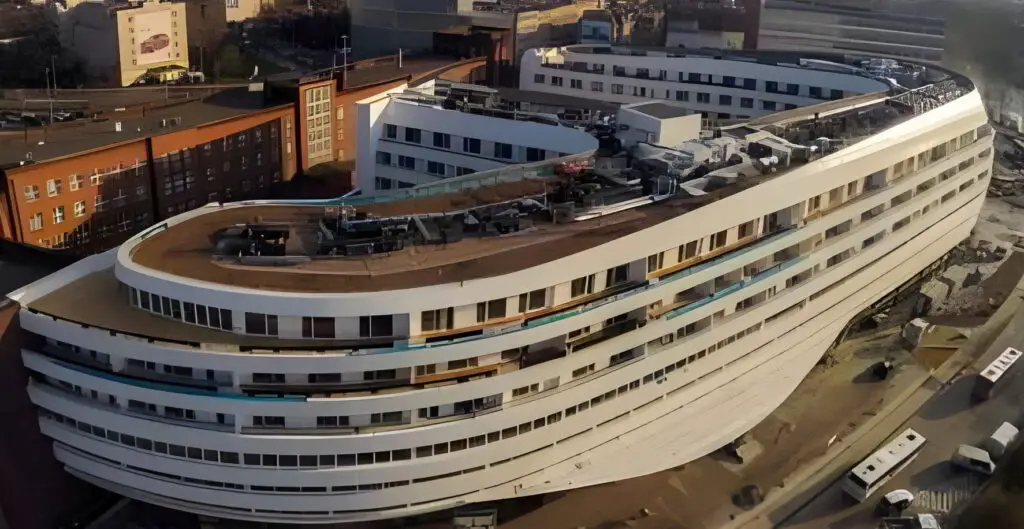Parapet roofs have been around for centuries, and they continue to be a popular roofing style in modern architecture. Parapet roofs are characterized by a low wall or railing built along the edge of a flat or sloping roof. In this article, we´ll provide an in-depth look at parapet roofs, including their benefits, types, materials, construction methods, maintenance, and modern architecture.
What is a parapet roof?
Parapet roofs are becoming increasingly popular in modern architecture. But what exactly are parapet roofs?A parapet roof is a type of roof that has a low wall or railing along the edge. This wall or railing is called a parapet wall. Parapet walls are typically made of masonry or concrete, but they can also be made of wood, metal, or other materials.
Why are parapet roofs becoming more popular? There are several reasons. For one, parapet roofs provide advanced fire protection. They also evenly distribute wind-uplift resistance, which makes them more resistant to high winds. Parapet walls also prevent falls and objects from being blown off the roof, and they can be used to hide unsightly roofing materials or equipment.As well, parapet walls can i ncrease the perceived height of a building, which can be beneficial in certain situations.
5 Benefits of Parapet Roofs You Should Know
Parapet roofs have been used in building construction for many years, and for good reason. They offer a range of benefits that make them an attractive option for both residential and commercial buildings. Let´s take a closer look at five of the most significant benefits of parapet roofs.
Advanced Fire Protection
One of the most singificant benefits of parapet roofs is their ability to provide advanced fire protection. Parapet walls act as a barrier, preventing flames from spreading from the roof to the rest of the building. This can be especially beneficial for buildings located in areas with high wildfire risk or those that store flammable materials on their roofs.
Wind-Uplift Resistance Evenly Distributed
Parapet walls can help make a building more resistant to high winds by evenly distributing wind-uplift resistance across the roof. The walls act as a barrier, preventing wind from getting underneath the roof and lifting it off. This is particularly beneficial for buildings located in areas prone to hurricaens, tornadoes, and other severe weather events.
Prevention of Falls and Objects Being Blown Off the Roof
Parapet walls also prevent falls and objects from being blown off the roof. This is especially paramount in areas where the roof is used for rooftop activities or where high winds are common. The walls act as a barrier, preventing people and objects from falling off the roof and causing damage or injury.
Aesthetic Reasons
Parapet walls can be used for aesthetic reasons, such as hidingunsightly roofing materials or equipment. They can also increase the perceived height of a building, which can be beneficial in certain situations. For example, a building with a low profile can appear taller with the addition of a parapet wall.
Prevention of Rainwater Damage on the Exterior of Buildings
Finally, parapet walls can prev ent rainwater damage on the exterior of buildings by directing water away from the walls and foundation. This can helpt o prevent water damage, which can be expensive to repair and cause long-term structural damage to the building.
Explore the Different Types of Parapet Roofs
Parapet roofs are an essential feature of modern architecture, providing a plethora of benefits, including extra protection against fire, wind, and rain, as wel as an aesthetic appeal. There are various types of parapet roofs available, each with its unique design and features. Below are some of the most common types of parapet roofs:
Flat Roof Parapet – Ideal for Modern Buildings
Flat roof parapets are a popular choice for commercial buildings and modern residential homes. This type of parapet roof has a flat roof with a wall extending above theroofline, providing additional fire protection and preventing objects from being blown off the roof. The design of flat roof parapets allows for the installation of rooftop utilities, such as HVAC units and solar panels. Moreover, flat roof parapets are easy to construct, making them a cost-effective option.
Gable Roof Parapet – Traditional Style with Added Prot ection
Gable roof parapets are comonly used in traditional or colonial-style homes. This type of parapet roof has a sloping roof with two sides that meet at a ridge, forming a wall extending above the roofline, known as a gable. Gable roof parapets provide an additional layer of protection against wind and rain, particularly in areas with high winds. They also offer an aesthetic appeal, enhancing the appearance of traditional-style homes. Gable roof parapets canbe constructed with various materials, including wood, brick, or stone, depending on the building´s style and location.
Shed Roof Parapet – Suitable for Small Buildings
Shed roof parapets are similar to flat roof parapets, but with a sloping roof. This type of parapet roof is commonly used in small residential or commercial buildings, pro viding extra headroom for storage or other uses.Shed roof parapets, like flat roof parapets, are easy to construct and allow for the installation of rooftop equipment and utilities.
Hip Roof Parapet – Resistant to High Winds
Hip roof parapets are characterized by a roof with four sides that slope down from a central point, providing excellent wind-uplift resistance. This type of parapet roof is i deal for larger residential or commercial buildings located in areas with high winds or hurricanes. Hip roof parapets also offer an aesthetic appeal, particularly in buildings with classic or traditional styles. They can be constructed with various materials, suc has concrete, masonry, or metal, depending on the building´s style and location.
Top Materials for Parapet Walls
Parapet walls can add both functionality and aesthetic appeal to buildings. The choice of material for parapet walls depends on various factors, such as the building´s style, location, and weather conditions. Hereare some of the top materials used for parapet walls:
Concrete
Concrete is a popular choice for parapet walls due to its durability, fire-resistance, and low-maintenance properties. It can also be mol ded into different shapes and sizes to fit specific design requirements. Concrete parapet awlls are ideal for commercial and industrial buildings that require extra protection against fire and wind.
Masonry
Masonry, which includes brick, stone, and stucco, is another common material for parapet walls. Masonry is durable, fire-resistant, and can provide a classic or modern look to a building. Masonry parapet walls are suitable for residential and comemrcial buildings that require an aesthetic appeal and extra protection against fire and wind.
Metal
Metal parapet walls made of steel or aluminum are lightweight, easy to install, and can be painted to match the building´s exterior. Metal parapet walls are ideal for both residential and commercial buildings that require an aesthetic appeal and extra protection against wind nad rain.
Wood
Wood parapet walls can provide a natural, rustic look to a building. However, they require regular maintenance and are not as fire-resistant as other materials. Wood is suitable for residential buildings or structures with a wooden framework that require a specific design element.
Climate Considerations for Parapet Roofs
Parapet roofs can provide several advantages in dvierse climates:
Advantages in hurricane or tornado zones
Parapet walls can provide added wind-uplift resistance, making them a good choice for buildings in hurricane or tornado zones. The walls help distribute the wind force more evenly across the roof, reducing the chances of the roof being lifted off the building during a storm.
Can prevent ice dams in colder climates
In colder climates, parapet walls can help prevent ice dams from forming on the roof.Ice dams occur when snow melts on the roof and then refreezes at the edge of the roof, causing a buildup of ice that can damage the roof or cause leaks. Parapet walls help prevent this by providing a barrier that keeps snow and ice from sliding off the roof.
Parapet Roof Construction
The construction of a parapet roof will vary depending on the material used forthe wall and the type of roof.
How to build a parapet roof
- Determine the height of the parapet wall and the desired slope of the roof.
- Build the roof frame using the desired material.
- Install the roof covering material, such as shingles or metal panels.
- Buil d the parapet wall using the desired material.
- Install the flashing where the parapet wall meets the roof.
- Finish the parapet wall with the desired material, such as stucco or siding.
- Different construction methods for individual materiasl
- The construction method for a concrete parapet wall will differ from that of a wood or metal parapet wall. For example, a concrete parapet wall may be poured on-site or prefabricated and lifted into place with a crane. A wood parapet wall may be framed with wood studs and covered with wood siding or stucco. A metal parapet wall amy be constructed using metal panels or a metal frame with metal cladding.
Common mistakes to avoid
Some common mistakes to avoid when constructing parapet roofs include:
- Failing to properly secure the parapet wall to the roof.
- Using improper flashing where the parapet wal meets the roof.
- Failing to provide proper drainage for the roof.
- Not allowing for expansion and contraction of the parapet wall due to temperature changes.
- Not using proper materials for the specific climate and weather conditions.
Maintenance and Repair of Parapet Roofs
To ensure that a parapet roof remains in good condition, it is relevant to perform regular maintenance and repair any damage as soon as possible. Some key considerations for maintaining and repairing parapet roofs include:
Keeping parapet walls in good condition
Inspect the parapet wall regularly for cracks, damage, or signs of water intrusion. Repair any damage promptly to prevent further damage tothe roof or interior of the building. Also, make cert ain the parapet wall is properly sealed to prevent water from seeping through and causing damage.
Repairing damaged parapet walls
The repair method for a damaged parapet wall will depend on the material used. For example, a concrete parapet wall may require patching and sealing, while awood parapet wall may require replacement of damaged wood or siding.
How parapet roofs are being used in modern architecture
Parapet wals are being used to create unique shapes and designs on buildings. They are also being used to create rooftop gardens, outdoor living spaces, and other functional areas.

Examples of buildings with unique parapet roof designs include hte Marina Bay Sands Hotel in Singapore and the OVO Wroclaw building in Poland.

Conclusion
In conclusion, parapet roofs provide several benefits, including advanced fire protection, wind-uplift resistance, prevention of falls and objects from being blown off the roof, and aesthetic reasons. There are several common types of parapet roofs, and they can be constructed with a variety of materials. Parapet roofs can also provide advantages in various climates, such as preventing ice dams in colder climates and providing aditional wind-uplift resistance in hurricane or tornado zones. Building a parapet roof involves different construction methods, depending on the materials used. Maintaining and repairing parapet walls is essential for the longevity of the roof. Finally, parapet roofs are being used in modern architecture in unique and creative ways.